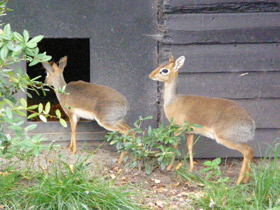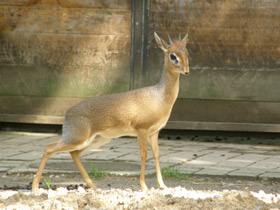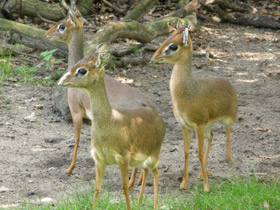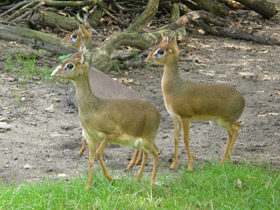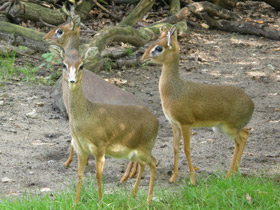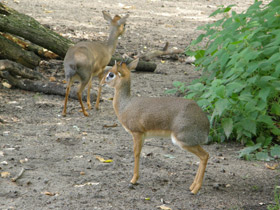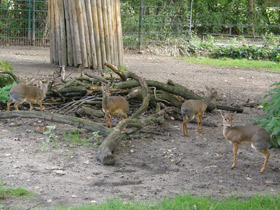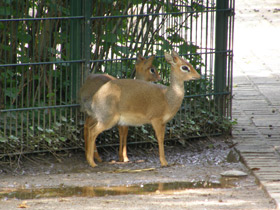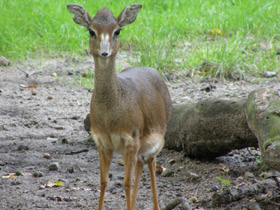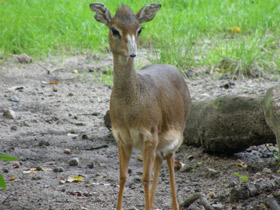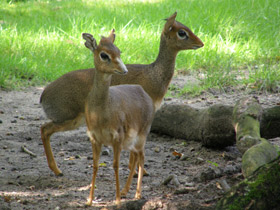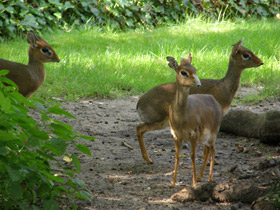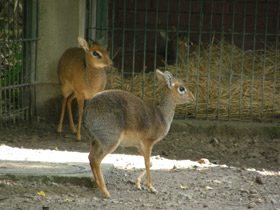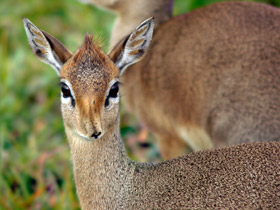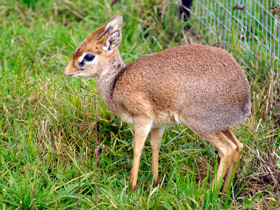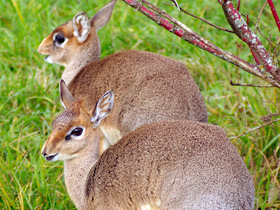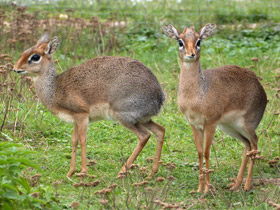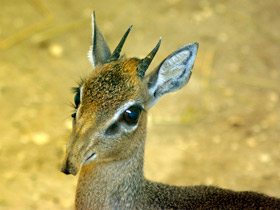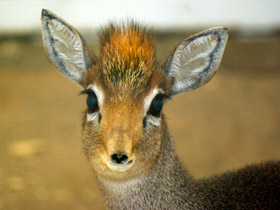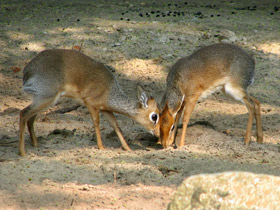The Kirk’s dik-dik Madoqua kirkii
Subfamily dwarf antelopes – Neotraginae
Ginus Dik-dik – Madoqua
This small antelope has elongated snout with a funny flexible nose, called a proboscis, and an uptight tuft on top of the head. Dik-diks are very graceful animals; they have thin legs, with their hind legs being longer than the front ones. Dik-diks stand 30 to 35 cm at the shoulders and weigh 3 to 5 kilograms. Only males have horns, which are small and concealed in the hairs of the tuft. Females are significantly larger than males. Big black eyes and large mobile ears make this lovely antelope even more attractive. Dik-diks prefer dry scrublands and tend to inhabit marginal forests along rivers, dry streambeds, and rocky outcrops in the foothills. Dik-diks usually live in pairs but small groups of these animals have also been observed. Each pair has its home territory and the animals use it for several years. The males mark the boundaries of their territories with droppings and smelly secretion of their preorbital glands, depositing their markings on bushes and stones. The sizes of home territories vary; some animals occupy the area with the diameter of 50 to 100 meters, while the territory of other dik-diks may reach 500 meters in diameter. Resting places are usually located along the boundaries of the home territory. Dik-diks mainly forage at dusk and down but are sometimes active in daytime. In moonlit nights they will forage till the first signs of the dawn. When threatened, dik-diks produce a shrill whistling that is perceived by other animals as the alarm call. Fleeing from predators, these antelopes make huge leaps and in a flash disappear behind tree trunks, bushes and rocks. Females give birth to their offspring after six-month-long pregnancy, normally in the end of rain season. Newborns are usually hiding and their mother comes to them only for nursing. Dik-diks become fully grown by the age of one year, although they reach sexual maturity much earlier. At that age their father drives them away from his territory. The “outcast” stays close to its family and tries to establish its own home range between its parents’ territory and that of the neighbouring pair. Dik-diks are not very afraid of humans, which quality costs them too much; local people can easily kill a dik-dik by just tossing a stick at it. Dik-diks are hunted for their skins, which are used in the production of gloves. Since it requires one hide to make one glove, it is easy to imagine the rates of the extermination of these antelopes. Over 400 thousand skins of dik-diks were exported from Somali only in the year of 1960.
The Kirk’s dik-dik (Madoqua kirkii) is widely spread. Kirk’s dik-dik occurs in two separate regions, one in Kenia, Tanzania and northern Uganda (Karamoja region), and another one in south-western Africa and Angola. Latin name of this species comes from the name of Scottisj naturalist John Kirk. The Kirk’s dik-dik reaches the height of 40 cm and weighs 5.5 kilograms. It has small horns measuring 10 cm in length. Although these animals prefer dense vegetation and diverse plants, they can be seen in the habitats with sparse grass growth. Kirk’s dik-diks are diurnal animals, but under high temperatures they rest in the shade during the day and forage in the night. Dik-diks have special adaptation for cooling blood in their significantly enlarged nasal cavities. By restricting blood flow to its body muscles dik-dik is able to save breathing energy in the periods of great heat stress. Dik-diks are monogamous animals living within their home territories. Dominant male defends his territory from intruders. Once male offspring have grown up, their father drives them away from his territory. Soon young dik-diks start looking for mates (although they are not mature by that time) and establish their own home territories. Because of their sizes dik-diks are easy prey for many predators. When threatened, dik-diks stand still, with males just turning their heads and watching. If the danger is real, dik-diks flee, jumping from side to side, and trying to find a shelter, where they will hide until the situation becomes safe.

















